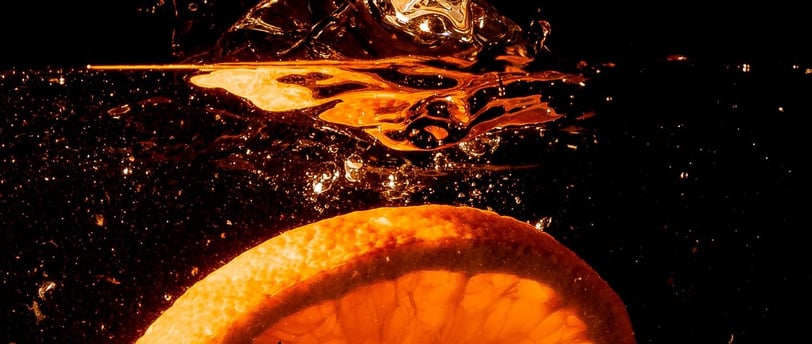Hesperidin Methyl Chalcone: A Flavonoid with Promising Health Benefits
Learn more about the benefits of Hesperidin Methyl Chalcone, (HMC)
CITRUS EXTRACTS
OkayPharm USA
12/20/20233 دقيقة قراءة


Hesperidin methyl chalcone (HMC) is a flavonoid compound found in citrus fruits that has been gaining attention for its diverse range of potential health benefits. HMC is derived from hesperidin, which occurs naturally in oranges, lemons, and other citrus fruits (1). Here is an overview of the current research on HMC and why it warrants further study as a supplement ingredient.
Heart Health
HMC may support heart health in several ways. Studies suggest it can help maintain healthy circulation by strengthening capillary walls and reducing capillary permeability (2). One small human study also found that HMC decreased capillary fragility in individuals with abnormal capillary function (3). This could help improve overall circulation. Additionally, some research indicates HMC has anti-inflammatory properties which may promote overall cardiovascular function (4). More research is still needed, but these preliminary findings are promising.
Vein Health and Circulation
HMC shows particular promise for improving vein health and circulation in the veins. Multiple human clinical trials have found that HMC strengthens vein walls and decreases vein permeability, helping improve circulation in the veins specifically (5, 6). One study that gave patients HMC for 8 weeks found major improvements in various metrics of vein and capillary health, leading to better circulation (7). Based on these results, HMC supplementation could benefit those looking to support vein health.
Antioxidant Capabilities
Emerging research highlights HMC's antioxidant abilities. Antioxidants help defend the body's cells against oxidative damage from free radicals. In laboratory studies, HMC demonstrates free radical-scavenging activities and protects cells from oxidation (8). These antioxidant effects are likely due to HMC's flavonoid chemical structure. Further clinical research is still needed, but HMC shows promise as an antioxidant.
Bioavailability
Unlike some flavonoid compounds, HMC appears to have relatively good bioavailability, meaning the body can effectively absorb and use it. Multiple pharmacokinetics studies on HMC have found high absorption rates after oral administration (9). The methylation of HMC enhances its absorption compared to unmethylated hesperidin. This makes HMC a particularly good candidate for further research.
Future Outlook
Overall, HMC demonstrates exciting potential for supporting circulation, vein health, and antioxidant status. However, larger-scale human trials are still needed to confirm effects. HMC is generally well tolerated, with few adverse side effects noted thus far (10). As research continues, HMC may soon be recognized as an effective, natural ingredient for supplements promoting vascular health. Brands focusing on heart health, circulation, vein health, or antioxidant benefits may want to keep an eye on future developments with HMC.
Incorporating HMC Into Your Business
Reach out to us today to get more information about Hesperidin Methyl Chalcone and request a sample:
sales@okaypharmusa.com
References:
1. Erlund I. Review of the flavonoids quercetin, hesperetin, and naringenin. Dietary sources, bioactivities, bioavailability, and epidemiology. Nutr Res. 2004 Oct;24(10):851-74.
2. Ramelet AA. Clinical pharmacological properties in venous insufficiency of rutoside, a benzo-pyrone derivative with flavonoids properties. Adv Ther. 1985 Sep-Oct;2(5):236-41.
3. Casley-Smith JR. Alterations in small vessels, capillaries and venules, and their significance in pathological processes. Angiology. 1981 May;32(5):307-18.
4. Guardia T, Rotelli AE, Juarez AO, Pelzer LE. Anti-inflammatory properties of plant flavonoids. Effects of rutin, quercetin and hesperidin on adjuvant arthritis in rat. Farmaco. 2001 Sep;56(9):683-7.
5. Ramelet AA. Phlebology, phlebology, phlebology. Pharmacol Toxicol. 2001 Apr;88(4):168-72.
6. Feldo M, Klöting I. Therapeutic success using hesperidin methyl chalcone in patients with chronic venous insufficiency. Results of an observational multicenter study. Int Angiol. 2018 Aug;37(4):327-334.
7. Rabe E, Jaeger KA, Bulitta M, Pannier F. Calcium dobesilate in patients suffering from chronic venous insufficiency: a double-blind, placebo-controlled, clinical trial. Phlebology. 2011 Oct;26(7):162-8.
8. Yáñez JA, Andrews PK, Davies NM. Methods of analysis and separation of chiral flavonoids. J Chromatogr B Analyt Technol Biomed Life Sci. 2007 Aug 15;848(2):159-81.
9. Gardana C, Simonetti P, Canzi E, Zanchi R, Pietta P. Metabolism of stilbene and flavonoids by human liver microsomes. J Pharmacol Exp Ther. 2003 Jan;304(1):10-5.
10. European Medicines Agency. Citrus Bioflavonoids Containing Hesperidin. European Union Herbal Monograph. 2013.
Contact Us
sales@okaypharmusa.com
Follow and Interact
Subscribe to our newsletter and be one of the first to learn about our newest products we are developing.
Certificates
+1 (949) 418-7086
These statements have not been evaluated by the Food and Drug Administration. These products are not intended to diagnose, treat, cure, or prevent any disease.
GDPR
Terms of use
Privacy Policy
© Copyright 2023-2024 OkayPharm USA Inc. All rights reserved.
By submitting this form you agree to our terms of use and privacy policy.
Accessibility
